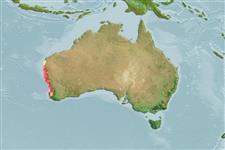Malacostraca |
Decapoda |
Palinuridae
Environment: milieu / climate zone / गहराई सीमा / distribution range
पारिस्थितिकी
; गहराई सीमा 0 - 120 m, usually 0 - 90 m. Subtropical, preferred 22°C (संदर्भ 107945); 22°S - 34°S, 113°E - 116°E (संदर्भ 4)
Indo-West Pacific: restricted to Western Australia.
Length at first maturity / आकार / Weight / Age
परिपक्व अवधि: Lm 7.0 range ? - ? cm Max length : 40.0 cm TL पुल्लिंग / अलिंग; (संदर्भ 4)
It has lengths of 40 cm, total body length; 14 cm, minimum carapace length; 8 and 10 cm, average carapace length; 9 to 11 cm, carapace length of ovigerous females or those with spermatophores (Ref. 4). The Western Australian Rock Lobster Fishery of this species has been certified by the Marine Stewardship Council (http://www.msc.org/) as well-managed and sustainable (http://www.msc.org/html/content_1277.htm). Occurs at depths between 0 and 90 m, rarely as deep as 120 m. The species are nocturnal and shelter in the daytime in rock crevices and among coral. They are omnivorous. They undertake limited migrations (Ref. 4). Juveniles spend 5 to 6 years in shallow-water reef areas, then moves offshore. They return from nocturnal foraging to the same den or one nearby, implying knowledge of topography (Ref. 106918). Phyllosomata of this species is observed to hitch and feed on its host salp Thetys vagina (Ref. 108806). Feeds on the coralline alga Corallina cuvieri (Ref. 122156).
Life cycle and mating behavior
परिपक्व अवधि | पुनरुत्पत्ति | मछलीऔ का अंडे देना | Eggs | Fecundity | Larvae
Brood and pelagic period lasts for 1.5 (Ref. 81134) and 10 months (Ref. 81163), respectively.
Holthuis, L.B. 1991 FAO Species Catalogue. Vol. 13. Marine lobsters of the world. An annotated and illustrated catalogue of species of interest to fisheries known to date. FAO Fish. Synop. 125(13):292p. Rome: FAO. (संदर्भ 4)
IUCN Red List Status
(संदर्भ 130435: Version 2025-1)
CITES status (संदर्भ 108899)
Not Evaluated
CMS (संदर्भ 116361)
Not Evaluated
Threat to humans
Human uses
मात्स्यिकी: व्यापारिक
FAO - मात्स्यिकी: landings | FishSource | Sea Around Us
साधन
अधिक जानकारी
PhysiologyOxygen consumption
Human RelatedStamps, coins, misc.
इंटरनेट स्रोत
Estimates based on models
Preferred temperature
(Ref.
115969): 20.2 - 24.2, mean 22.3 (based on 78 cells).
लौटाव
निम्न, न्यूनतम जनसंख्या दुगनी होने का समय 4.5 - 14 वर्ष। (K=0.09; tm=5).
Prior r = 1.15, 95% CL = 0.76 - 1.73, Based on 3 data-limited stock assessments.
Fishing Vulnerability
High vulnerability (55 of 100).
Climate Vulnerability
High to very high vulnerability (67 of 100).
Nutrients : Calcium = 109 [35, 184] mg/100g; Iron = 1.59 [1.21, 1.97] mg/100g; Protein = 20.2 [19.2, 21.3] %; Omega3 = 0.285 [0.185, 0.386] g/100g; Selenium = 48.3 [-31.7, 128.3] μg/100g; VitaminA = 0 μg/100g; Zinc = 1.79 [1.17, 2.40] mg/100g (wet weight); based on
nutrient studies.
